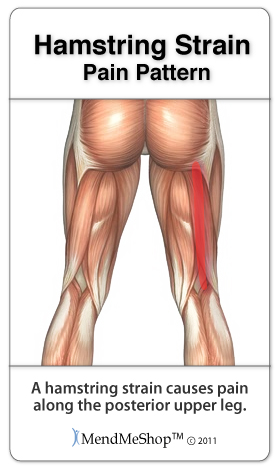|
| Symptoms of a Strained HamstringDecreased FlexibilityYou may experience stiffness or decreased range of motion (ROM) as a result of a pulled hamstring muscle. The tightness at the back of your thigh will make it difficult to flex your knee or straighten your leg. Your gait may be affected, or you may limp when you walk if the stiffness causes discomfort. You may be experiencing hamstring muscle spasm. An injury can make the muscle and/or nerves behave abnormally and improper contraction signals may be sent to the brain causing one or more of the hamstring muscles to spasm. With an avulsion, or rupture, you will experience difficulties walking without assistance, a cane, or crutches. You could even feel a gap in your muscle with a complete tear. Hamstring PainA sharp pain or twinges may be felt along the length of your hamstring or at a specific point on the back of your thigh. You may experience tenderness and/or muscle spasms in your hamstring muscle during active and resistive movements. Pain often increases when pressure is applied to the injured hamstring muscles.  It is possible to experience only mild pain when walking even if a tear in the muscle occurs, however, pain will increase if strenuous exercise is attempted. An avulsion, or complete tear causes extreme pain, even during rest. The torn tissue may bunch in the back of the thigh causing even more pain when the leg is bent. If you have a chronic injury, you may feel more of a dull ache that lasts for long periods of time. Pain can be experienced while sitting or walking up or down stairs/hills. Popping NoiseA popping or snapping sensation at the back of your thigh can often be heard and felt when your hamstring muscles are tearing. This often happens with a large force of hip flexion when your knee is extended (straightened) and may cause you to fall to the ground. Strained Hamstring TreatmentsHamstring injuries are frustrating to live with and healing can take a long time because it's difficult to give your leg the rest it needs. This is especially true for runners and other athletes that return to their sport too early. Re-injury is common but it prolongs recovery and may also lead to permanent damage and other conditions. Treating your hamstring strain correctly is essential to getting rid of your pain and restoring function to your upper thigh. Proper treatment will get you back to regular activities sooner, stop your pain, and reduce the risk of future re-injury. Learn More About Hamstring StrainHamstring Strain Causes Hamstring Strain Symptoms Hamstring Strain Progression (Grades of Strain) Hamstring Strain Diagnosis Hamstring Strain Home Treatments Hamstring Strain Surgery Hamstring Strain Post-Surgery Recovery Hamstring Strain Prevention Product specialists are available 9:00 am to 5:00 pm Eastern Standard Time Monday to Friday. If any question or concern arises, call us or simply send us an email at any time (we check our emails constantly all throughout the day and night.. even on holidays!). We will respond as soon as possible. North America Toll Free 1-866-237-9608 |
    |

